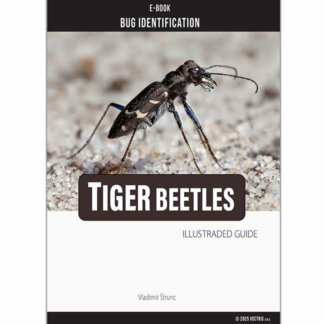Unique pictorial atlases for identifying Beetles. Tiger beetles, belonging to the family Cicindelidae, are fascinating insects known for their speed, predatory prowess, and ecological importance. This article delves into their role as both predators and prey, their ecological significance, and the challenges they face in a changing environment.
Beetles
Tiger Beetle predators
We recommend:
jeweled beetles, ground beetles, longhorn beetles, goliath beetle, stag beetle, carpet beetles
Tiger Beetles: Predators, Prey, and Ecological Significance
Tiger beetles are highly effective predators. Their sharp vision and rapid movements allow them to hunt a variety of small insects and arthropods. They employ a “pause-and-pursue” hunting strategy, where they locate prey by sight, sprint to capture it, pause to regain focus, and then attack. Their mandibles are powerful enough to subdue prey like beetles, caterpillars, ants, and larvae.
Books about Beetles
Unique pictorial atlases for identifying Beetles:
(2020) Tiger Beetles of the World, Cicindelidae, Illustrated guide to the genera
(2023) Tiger Beetles of Africa, Cicindelidae, Geographical guide to the family Cicindelidae
(2024) Tiger Beetles of Orient, Cicindelidae, Geographical guide to the family Cicindelidae
(2022) Ground Beetles of Africa, Afrotropical Region
(2022) Jewel Beetles of the World, Buprestidae, Illustrated guide to the Superfamily Buprestoidea
(2008) The Prionids of the World, Prioninae, Illustrated catalogue of the Beetles
(2010) The Prionids of the Neotropical region, Prioninae, Illustrated catalogue of the Beetles
Predatory Behavior
Interestingly, different species display preferences for prey types. For instance:
Calomera littoralis favors slow-moving prey such as small caterpillars.
Cicindela hybrida targets both slow-moving and medium-sized fast prey.
Defensive Strategies
While adult tiger beetles are agile and challenging to catch due to their speed (up to 5 mph), they still face threats from larger predators like birds. Some species have evolved unique defenses:
Cryptic Coloration: Species like Odontocheila nicaraguensis blend with their environment but reveal iridescent colors when disturbed to confuse predators.
Aposematism and Mimicry: Others, such as Pseudoxycheila tarsalis, have conspicuous patterns that mimic harmful insects like wasps and release distasteful secretions when attacked.
Larvae and eggs are more vulnerable. Predators include:
Birds (e.g., grackles): Known for digging up larvae.
Moles: Consume larvae in the soil.
Parasitic Wasps: Lay eggs on larvae, often leading to their death.
Ecological Role
Tiger Beetle predators
Tiger beetles play a dual role in ecosystems:
Pest Control: As predators, they help regulate populations of other insects.
Bioindicators: Their sensitivity to environmental changes makes them valuable indicators of ecosystem health. A decline in tiger beetle populations often signals habitat degradation or pollution.
Threats and Conservation
Despite their predatory efficiency, tiger beetles face significant threats:
Habitat Loss: Urbanization, agriculture, and climate change have reduced their preferred habitats like sandy areas or riverbanks. For example, the Miami tiger beetle has lost 98% of its habitat.
Climate Change: Rising temperatures have been linked to a reduction in body size among beetle species. This could impact their survival and ecological roles.
Conservation efforts focus on protecting critical habitats and mitigating climate change impacts. For instance, U.S. authorities have designated protected areas for endangered subspecies like the Miami tiger beetle.
Interesting Facts Tiger Beetle predators
Tiger beetles are among the fastest insects on Earth.
Their iridescent colors range from metallic green to red with spots.
They can lose sight of prey due to their speed but compensate by stopping frequently to refocus.
In summary, tiger beetles are not only remarkable hunters but also vital components of healthy ecosystems. Protecting them ensures the balance of biodiversity and provides early warnings of environmental disturbances.











